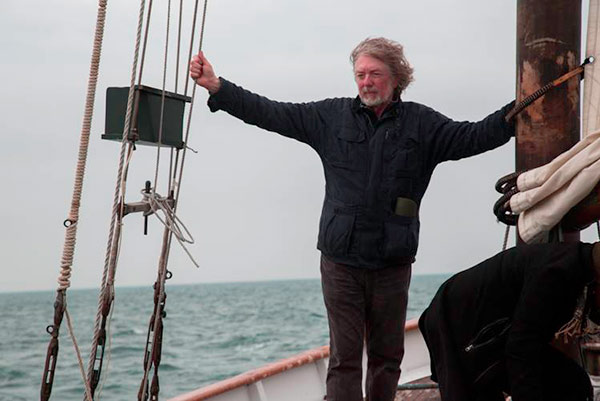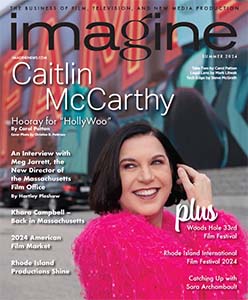By Carol Patton | Photos by Willow O’Feral
In April of this year Jay Craven brought a crew of fifty-seven and a cast of twenty to Nantucket for principal photography for PETER AND JOHN, a distinctly “seaside story” written around 1880 by French writer Guy de Maupassant. It tells the story of two brothers whose relationship strains when the younger one receives a strange inheritance and both brothers take an interest in a mysterious young woman.
Fortunes in experience have been won by those who spend time on the Island of Nantucket. Numerous stories about particularly creative individuals come to mind. I believe the whole of it would make for interesting study. Teacher and independent filmmaker Jay Craven’s experience lends to that pool as he has spent time on Nantucket since he was seventeen.
“The island has always been hospitable to my work,” says Jay Craven. “All of my films have screened there—going back to 1993. I’ve played the Gaslight, The Dreamland, The Sconset Casino, The Starlight, and the Athenaeum, that staged the first-ever retrospective of my work. I also directed the year-round teen screenwriting and filmmaking workshops in and out of the schools for the Nantucket Film Festivals…. So, I knew people and felt a sense of connection. I also saw how Nantucket is one community—and I thought there would be potential for intimate community involvement. It turns out that I underestimated the potential for this. The community response was extraordinary.
“This was a very ambitious 19th century period piece made with a very modest budget involving thirty-two students as a majority of the crew. It would not have been possible without so many fabulous people pitching in.”- Jay Craven
“The film became the equivalent of a barn-raising with literally hundreds of people pitching in, offering everything from boats and fresh-caught fish to historical artifacts, cakes, ferry tickets, housing, skillful location management, and dozens of kinds of volunteered expertise. This was a very ambitious 19th century period piece made with a very modest budget involving thirty-two students as a majority of the crew. It would not have been possible without so many fabulous people pitching in.
See the film’s Kickstarter campaign here
Jay wrote the script himself with students very involved in every step and every beat of narrative development and characterization. He had a collaborator on the earlier script development— but all of that writer’s material was dropped from the script largely because he couldn’t clear the rights to it.
Jay speaks of the island, “Nantucket was extremely hospitable to the production. Town officials were cooperative for permitting and location owners were generous in their collaboration. The owners and caretakers of our primary farm location were Jay speaks of the island, “Nantucket was extremely hospitable to the production. Town officials were cooperative for permitting and location owners were generous in their collaboration. The owners and caretakers of our primary farm location were nothing short of heroic. Catering was reasonably priced, compared to other productions I’ve staged. We arranged housing through the island youth hostel (for students) and the fabulous Maria Mitchell Association which takes on summer interns and opened that housing to us for crew. We shot for twenty-nine days of principal photography and another five days for second unit.
For filmmaker Craven, “Flexibility is the operative concept to guide a successful film shoot. And time is the overriding factor for production. How fast can we move? What do we do when we lose even twenty minutes due to the dozens of complications that can emerge as hair, make-up, costume, lighting, camera, production, and transportation departments work to coordinate perfectly—but often can’t, due to no fault of their own. The need for flexibility also determines how effective an actor can be in playing his or her role. As a director, I try to find three or four ways into any specific beat of a scene. For each actor. Filmmaking is a process of discovery and it thrives through choices that bubble up through the shifting sands of instinct, actor chemistry, and dramatic circumstances that can play in a variety of ways. Invention gives birth to the most compelling and satisfying character and story beats.
To get through any shoot becomes the most rewarding accomplishment to date, because it allows you to advance your vision and experience of filmmaking. So, I’d say the completion of principal photography for PETER AND JOHN a most satisfying moment in the process of filmmaking. If I get successfully through post-production and am able to complete a resonant film—then that will be the most rewarding accomplishment—and I’ll feel it on opening night, if Nantucketers like the picture.
“For me, HIGH WATER was my first narrative and opened the door for me to understand how you work with actors and crew and production challenges. WHERE THE RIVERS FLOW NORTH expended the playing field substantially—and broke ground for me in the areas of working with actors, developing a vivid sense of place, and drawing the region together for funding and grass-roots distribution. A STRANGER IN THE KINGDOM was probably my most difficult production — it threatened to fall apart a dozen times and required the intervention of Governor Howard Dean after a 3 am phone call begging his support for a bank loan that was being held up by state officials. Sadly, that film remains my orphan picture that did not receive a lot of exposure, partly due to its racial theme. THE YEAR THAT TREMBLED was fabulous and fun — because someone else (Tyler Davidson and Scott Lax) produced it. Windy Acres was my foray into TV comedy production on a super-low budget. It played twelve PBS affiliates around the country and landed two New England Emmys—and was the second most popular TV show in the history of Vermont Public Television (the first was the University of Vermont girls’ basketball championship).
“DISAPPEARANCES marked my career ambition — to tell that story about rough and tumble whiskeysmuggling during Prohibition. And it was a pleasure to partner with Kris Kristofferson who showed uncommon grace and generosity on so many levels. And here we are with PETER AND JOHN, that has, even before it’s completed, yielded such a satisfying experience of community engagement.
“Plus I’ve a got a cool wife and two fabulous sons who have always been close at hand for these projects— and continue to be inspired and productive in their own work and lives. So, I’ve been lucky. My ability to launch this new mode of production, through Marlboro College where I teach—also helps me advance toward my most burning desire as a filmmaker — toward a sustainable model for independent regional production. We’re getting there. It’s a lot of work. But it’s very rewarding. Marlboro College and the participating principal partner colleges (Wellesley, Mount Holyoke, Boston College, Boston University, Sarah Lawrence, University of Vermont, Smith, and Lyndon State) deserve special thanks for this—and for also facilitating the most fulfilling teaching experiences I’ve had.
“We are now editing — and, yes, the Massachusetts Film Incentive program was important to our decision to shoot here. I’ve always talked about my work as distinctive to New England, even though most of it, to date, has been based in Vermont. But I’ve always seen this enterprise as being chiefly about exploring a New England sense of place. And my barnstorming approach to distribution— where we play movie theaters, yes, but also town halls, fire stations, schools, museums, libraries, and church basements—has always been about building connectivity within New England, north and south. We’ll start the release of PETER AND JOHN on Nantucket, where we’ll play the Dreamland and Starlight—and some unconventional venues too, like the Muse and Chicken Box—to reach the broadest audience we can. We’ll also play every other town on the Cape and Islands next summer and will reach out extensively into Boston, Hartford, and the rest of New England and upstate New York, the larger region that we see as central to all of my films.
We’re on the road this summer—with NORTHERN BORDERS, the film I made through my first Marlboro film intensive (2012) that stars Bruce Dern, Genevieve Bujold, and Seamus Davey- Fitzpatrick. We’ve played 86 New England towns so far and we’ll play another 60 this summer and fall. We’ll do the same thing with PETER AND JOHN. We may preview the film during the Nantucket Christmas Stroll weekend in early December and then play a handful of New England preview dates next winter and spring. We’ll have an official gala premiere next June on Nantucket and will launch our New England touring then. We’ll also look to play larger cities outside of New England and work our way into DVD, TV, digital, and foreign release. This is our usual pattern. We have managed our own release to theaters and non-conventional venues since 1984 — and have played more than 400 cities and towns across the country this way—since then.
Jay tells me, “I was raised by a Texas grandmother who loved movies, mostly westerns and Tennessee Williams pictures. So, when my peers were watching DUMBO and LADY AND THE TRAMP, I was checking out RED RIVER and CAT ON A HOT TIN ROOF. Anything with gunslingers and distraught southern women. She also turned me onto James Bond. I wrangled a scholarship to a boy’s boarding school when I was twelve—and on weekends, we’d watch Hitchcock and THE PINK PANTHER and DR. STRANGELOVE. Then, when I was sixteen, I saw Antonioni’s BLOW UP in a rural Pennsylvania drive-in. I was hooked. I knew I had to make this happen.

Flanked by Jay Craven, Christian Coulson and crew, Gary Farmer, who plays Smoke, holds a slate during the filming of “Peter and John”.
Carol Patton is the founder and publisher of IMAGINE Magazine. She introduced and is a defender of Film Tax Credits in New England.















